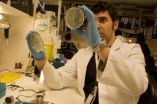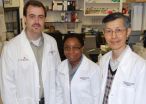(Press-News.org) The benefit of therapeutic arthroscopy with lavage and possible debridement for the treatment of arthrosis of the knee joint (gonarthrosis) is not proven. There was no hint, indication or proof of benefit of therapeutic arthroscopy in comparison with non-active comparator interventions, e.g. sham surgery, for any patient-relevant outcome. From the active comparator therapies, only the injection of glucocorticoids into the knee joint produced worse results than arthroscopy for the outcome "global assessment of the symptoms of gonarthrosis".
This was the result of the final report published by the German Institute for Quality and Efficiency in Health Care (IQWiG) on 12 May 2014. A new study, in which strengthening exercises under the supervision of a physical therapist were used as comparator therapy, did not change this assessment.
Arthroscopy aims to relieve symptoms
Gonarthrosis, also called "osteoarthritis of the knee", is a chronic progressive disease, which often occurs in both knees at the same time. Increasing failure of the joint is associated with changes in the structure of the joint, pain, and loss of flexibility. It makes daily tasks like climbing stairs difficult and can reduce quality of life. Around 17 per cent of men and 27 per cent of women in Germany develop osteoarthritis at some point in their lives. This disease most commonly affects the hip and knee joints. The risk factors of gonarthrosis include age, sex, genetic factors and obesity.
Therapeutic arthroscopy of the knee joint is an endoscopic procedure where the knee joint is flushed with saline solution. Sometimes meniscal or cartilage abnormalities are removed or smoothed (debridement). The aim of this procedure is to relieve symptoms like pain and improve flexibility.
Wide variety of treatments
IQWiG compared this treatment with several other interventions, including no treatment, sham treatment and active treatments without arthroscopy, such as glucocorticoid injections into the knee joint. The effect of these treatments on the daily activities and the quality of life of the people affected was of particular interest. Changes in the severity of symptoms and possible side effects of the treatments were also compared, for example infections after surgery.
Studies were subject to uncertainty
Eleven randomized controlled trials with a total of more than 1000 patients were identified for this research question, but a considerable number of them were subject to uncertainty. For example, in many cases the interventions were not blinded: The patients knew then whether or not they had arthroscopy. Sham arthroscopies can be done, however, in which patients receive a small skin incision on the knee, but no further surgery. This kind of "placebo surgery", albeit controversial, is particularly informative for the assessment.
No advantage over sham interventions
No benefit of therapeutic arthroscopy in comparison with sham surgery and no treatment could be derived from most study results, and no clear conclusion could be drawn on potential harm from adverse treatment effects. It was already known that invasive treatment methods often have a particularly strong placebo effect. However, the extent of improvement perceived by the patients after placebo arthroscopy in these studies was surprising.
The comparison with active interventions was also sobering. Arthroscopy had a slight advantage only in comparison with glucocorticoid injection into the knee joint: The symptoms were somewhat milder. The study did not provide any information about whether the quality of life of the people affected also improved in comparison with the injection.
Also no benefit in comparison with strengthening exercises
Data from patients who had gonarthrosis with damage of the medial meniscus were used for the comparison of arthroscopic interventions with strengthening exercises under the supervision of a physical therapist. There was no significant effect in the two outcomes "pain" and "global assessment of the symptoms" at any time point of the study. Hence the overall result is the same as in the preliminary report: The benefit of arthroscopy of the knee joint for the treatment of gonarthrosis is not proven.
Process of report production
IQWiG published the preliminary results in the form of the preliminary report in September 2013 and interested parties were invited to submit comments. At the end of the commenting procedure, the preliminary report was revised and sent as a final report to the commissioning agency in May 2014. The written comments submitted were published in a separate document at the same time as the final report. The report was produced in collaboration with external experts.
The executive summary provides an overview of the background, procedure and further results of the report.
INFORMATION: END
Arthroscopy of the knee joint for arthrosis: No benefit detectable
Inclusion of new study data did not change the result of IQWiG's preliminary report
2014-05-13
ELSE PRESS RELEASES FROM THIS DATE:
Identified 2 new genes involved in the more aggressive prostate cancer
2014-05-13
A study by the Columbia University Nova York, in collaboration with the Catalan Institute of Oncology , Belvitge Biomedical Research Institute (ICO-IDIBELL) has identified two new genes that lead to more aggressive forms of prostate cancer. The work done by Alvaro Aytes under the direction of Cory Abate-Shen , director of the Herbert Irving Comprehensive Cancer Center of the Columbia University, has been published in the latest issue of Cancer Cell.
Prostate cancer
Prostate cancer is the most common in men in Europe( accounts for 20% of all male tumors). The incidence ...
A tale of survival
2014-05-13
Frankfurt am Main, Germany, May 12, 2014. Hydrogen sulphide (H2S) is a potent inhibitor of aerobic respiration. However populations of shortfin molly fish managed to colonise springs with high concentrations of dissolved hydrogen sulphide. In a new study researchers from LOEWE Biodiversity and Climate Research Centre (BiK-F) and the Goethe University Frankfurt present evidence of genetic changes minimizing the harmful effects of H2S which enable the fish to survive in this deleterious environment. The study provides insight into the molecular mechanisms of this key adaptation ...
Bird invaders 'moving in' to UK's nature reserves
2014-05-13
A new study by scientists at the University of York and the RSPB Centre for Conservation Science has demonstrated that nature reserves and other areas specially protected for wildlife, as well as being vital for native species, are very important for helping European birds to expand their ranges into Britain naturally. The catch is that protected areas are also at increasing risk of invasion by species that have been introduced from further afield.
The research, published in the journal Diversity and Distributions, explores how the UK's special places for nature have ...
Comet theory false; doesn't explain Ice Age cold snap, Clovis changes, animal extinction
2014-05-13
Controversy over what sparked the Younger Dryas, a brief return to near glacial conditions at the end of the Ice Age, includes a theory that it was caused by a comet hitting the Earth.
As proof, proponents point to sediments containing deposits they believe could result only from a cosmic impact.
Now a new study disproves that theory, said archaeologist David Meltzer, Southern Methodist University, Dallas. Meltzer is lead author on the study and an expert in the Clovis culture, the peoples who lived in North America at the end of the Ice Age.
Meltzer's research team ...
Chemists design molecules for controlling bacterial behavior
2014-05-13
Chemists in the College of Arts and Sciences have figured out how to control multiple bacterial behaviors—potentially good news for the treatment of infectious diseases and other bacteria-associated issues, without causing drug resistance.
Yan-Yeung Luk, associate professor of chemistry, has spearheaded the discovery, in conjunction with his research lab at Syracuse University and the Wang Lab at SUNY Upstate Medical University. Their findings are the subject of a forthcoming article in the journal ChemBioChem (John Wiley & Sons Inc.).
"Since the discovery of the first ...
UCSF: E-cigarettes expose people to more than harmless vapor, should be regulated
2014-05-13
In a major scientific review of research on e-cigarettes, UC San Francisco scientists found that industry claims about the devices are unsupported by the evidence to date, including claims that e-cigarettes help smokers quit.
The review marks the first comprehensive assessment of peer-reviewed published research into the relatively new phenomenon of electronic cigarettes.
The devices, which are rapidly gaining a foothold in popular culture particularly among youth, are marketed as a healthier alternative to tobacco smoking, as an effective tool to stop smoking, ...
Scientists from USC and NYU design a molecule that blocks cancer growth in mice
2014-05-13
A team of researchers from USC and NYU has developed and patented a small molecule that interferes with cancer progression with minimal side effects.
The molecule prevents two critical proteins from interacting by mimicking the surface topography of one protein – like wearing a mask – which tricks the other protein into binding with it. This stops a so-called "transcription factor" that controls the transcription of genetic information. That transcription factor is what would have created an aberrant gene expression, contributing to the cancer growth.
Because of the ...
Scientists slow brain tumor growth in mice
2014-05-13
Much like using dimmer switches to brighten or darken rooms, biochemists have identified a protein that can be used to slow down or speed up the growth of brain tumors in mice.
Brain and other nervous system cancers are expected to claim 14,320 lives in the United States this year.
The results of the preclinical study led by Eric J. Wagner, Ph.D., and Ann-Bin Shyu, Ph.D., of The University of Texas Health Science Center at Houston (UTHealth) and Wei Li, Ph.D., of Baylor College of Medicine appear in the Advance Online Publication of the journal Nature.
"Our work ...
Birth by C-section, early antibiotic use put kids at risk for allergic esophagitis
2014-05-13
Children delivered by cesarean section and those given antibiotics during early infancy appear more prone to developing allergic inflammation of the esophagus — the muscular tube that connects the mouth to the stomach — according to results of a study by investigators from the Johns Hopkins Children's Center and Harvard Medical School.
The findings, published online May 2 in the Journal of Allergy and Clinical Immunology: In Practice, reveal that early antibiotic treatment and C-section delivery may somehow precipitate disease development by altering a child's microbiota ...
Professional surfer back in the water after successful surgery to treat rare bone cancer
2014-05-13
LOS ANGELES (May 13, 2014) – When professional surfer Richie Lovett began experiencing hip pain at 31, he attributed it to his athletic lifestyle. But after months of discomfort and preliminary tests, the Australian native learned the pain was caused by a cancerous tumor in his femur or thigh bone.
"As a professional athlete, I was blindsided by the news that I had cancer," said Lovett. "I realized very quickly that cancer would have a profound effect on my life. I knew I needed an experienced oncologist to tackle this disease, so I began an international search to find ...
LAST 30 PRESS RELEASES:
Report on academic exchange (colloquium) with Mapua University
Sport in middle childhood can breed respect for authority in adolescence
From novel therapies to first-in-human trials, City of Hope advances blood cancer care at the American Society of Hematology (ASH) annual conference
Research aims to strengthen the security of in-person voting machines
New study exposes hidden Alzheimer’s 'hot spots' in rural Maryland and what they reveal about America’s growing healthcare divide
ASH 2025: Study connects Agent Orange exposure to earlier and more severe cases of myelodysplastic syndrome
ASH 2025: New data highlights promise of pivekimab sunirine in two aggressive blood cancers
IADR elects George Belibasakis as vice-president
Expanding the search for quantum-ready 2D materials
White paper on leadership opportunities for AI to increase employee value released by University of Phoenix College of Doctoral Studies
ASH 2025: New combination approach aims to make CAR T more durable in lymphoma
‘Ready-made’ T-cell gene therapy tackles ‘incurable’ T-cell leukemia
How brain activity changes throughout the day
Australian scientists reveal new genetic risk for severe macular degeneration
GLP-1 receptor agonists likely have little or no effect on obesity-related cancer risk
Precision immunotherapy to improve sepsis outcomes
Insilico Medicine unveils winter edition of Pharma.AI, accelerating the path to pharmaceutical superintelligence
Study finds most people trust doctors more than AI but see its potential for cancer diagnosis
School reopening during COVID-19 pandemic associated with improvement in children’s mental health
Research alert: Old molecules show promise for fighting resistant strains of COVID-19 virus
Journal of Nuclear Medicine Technology supplement highlights advances in theranostics and opportunities for growth
New paper rocks earthquake science with a clever computational trick
ASH 2025: Milder chemo works for rare, aggressive lymphoma
Olfaction written in bones: New insights into the evolution of the sense of smell in mammals
Engineering simulations rewrite the timeline of the evolution of hearing in mammals
New research links health impacts related to 'forever chemicals' to billions in economic losses
Unified EEG imaging improves mapping for epilepsy surgery
$80 million in donations propels UCI MIND toward world-class center focused on dementia
Illinois research uncovers harvest and nutrient strategies to boost bioenergy profits
How did Bronze Age plague spread? A sheep might solve the mystery
[Press-News.org] Arthroscopy of the knee joint for arthrosis: No benefit detectableInclusion of new study data did not change the result of IQWiG's preliminary report



